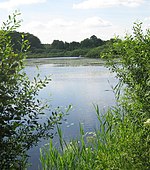Höör Sandstone
The Höör Sandstone is a geologic formation in Skåne County, southern Sweden. It is Early Jurassic (Hettangian-Pliensbachian) in age. This unit outcrops in central Skane on a few isolated exposures, being traditionally subdivided into the lower “millstone” (“kvarnstenen”) and the upper “buildingstone”. The lowermost layers where also claimed to host Rhaetian strata, however latter works suggested that the layers devolved as red beds, were part of the new Hörby Formation, thus delimitating the Höör sandstone to the lower Jurassic. It has been assumed to be limited to Hettangian-Sinemurian layers, yet recent palynological analysis suggest the uppermost section is of Pliensbachian age, underlying and maybe interacting with the younger volcanic deposits. The Höör sandstone represents a mostly fluvial unit with a rich collection of fossil plants, yet also includes brackish bivalves in some layers, pointing to marine ingressions locally.
Excerpt from the Wikipedia article Höör Sandstone (License: CC BY-SA 3.0, Authors).Höör Sandstone
M 1975, Höörs kommun
Geographical coordinates (GPS) Address Nearby Places Show on map
Geographical coordinates (GPS)
| Latitude | Longitude |
|---|---|
| N 55.98 ° | E 13.63 ° |
Address
Tjörnarps Sjöpark
M 1975
243 71 Höörs kommun
Sweden
Open on Google Maps







